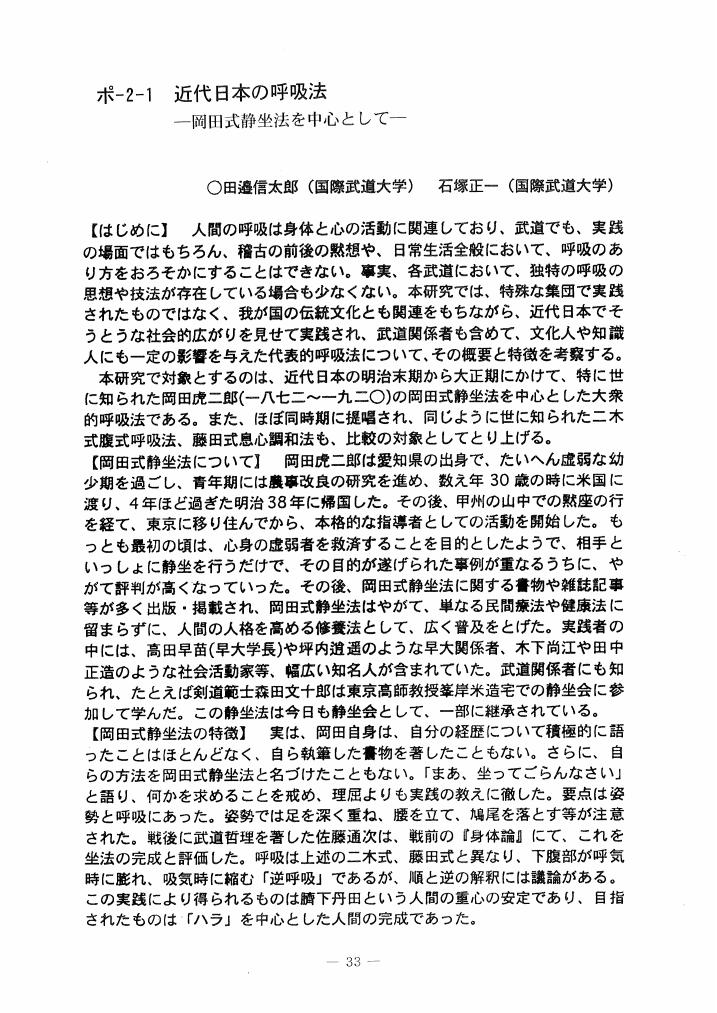13 0 0 0 OA 近代日本の呼吸法―岡田式静坐法を中心として―
- 著者
- 田邉 信太郎 石塚 正一
- 出版者
- 日本武道学会
- 雑誌
- 武道学研究 (ISSN:02879700)
- 巻号頁・発行日
- vol.32, no.Supplement, pp.33, 1999 (Released:2012-11-27)
2 0 0 0 OA 武道体験と身心活動との関連性―弓道部学生を事例として
- 著者
- 石塚 正一 田邉 信太郎
- 出版者
- 日本武道学会
- 雑誌
- 武道学研究 (ISSN:02879700)
- 巻号頁・発行日
- vol.39, no.Supplement, pp.56-56, 2006 (Released:2012-11-27)
- 著者
- 田邉 信太郎
- 出版者
- 国際武道大学
- 雑誌
- 武道・スポーツ科学研究所年報 (ISSN:13418505)
- 巻号頁・発行日
- no.14, pp.25-33, 2008
1 0 0 0 OA 武道家の黙想時の脳波活動について
- 著者
- 石塚 正一 田邉 信太郎
- 出版者
- 日本武道学会
- 雑誌
- 武道学研究 (ISSN:02879700)
- 巻号頁・発行日
- vol.28, no.1, pp.23-32, 1995-07-31 (Released:2012-11-27)
- 参考文献数
- 20
In the field of Budo, mokusou (meditation) is a means of controlling mind and body as a part of the training regimen, and approximates meditative practices in Zen. During meditation, the budo practitioner maintains a prescribed posture, regulates his (or her) respiration, and controls activities of his consciousness. There can be no doubt that this psychosomatic control produces a special form of mental activity.In order to investigate brain wave activity during meditation, the brain waves of three kendo and three judo practitioners were monitored and recorded at 13 locations on the cranium (i. e., FZ, CZ, PZ, F3, F4, T3, T4, C3, C4, P3, P4, T5, and T6), in accordance with the 10-20 electrode system. The brain waves were processed by fast Fourier transformation for calculation of the power spectral values. In order to consolidate the immense amount of data, factor analysis (identification of factors, based on maximum likelihood, and EQUAMAX rotation) was performed to extract five factors (i. e., delta, theta, alpha-I, alpha-II, and beta). In addition, an analysis of variance (ANOVA) was performed for scoring of the five factors for the purpose of comparing brain wave activity during meditation with that during rest. By this comparison we found a significant disparity in the cases of the theta and alpha-II factors. The brain wave activity represented by these factors was lower during meditation than during rest.Since meditation as practiced in budo is a training method akin to that employed in Zen, it was initially anticipated that the frequency of alpha waves monitored during it would be lower. However, investigation of the spectral distribution during meditation determined that the wave frequency tended to be higher rather than lower. This relative increase of the frequency of alpha-wave is a phenomenon that has been found in the brain wave patterns of masters of Qi-gong during Qi-gong practice. It is conceivable that this increase in frequency is caused by the high-order activity of the consciousness accompanying the process of conjuring up images during meditation.
1 0 0 0 OA 黙想に関する生理心理学的研究(第1報)―実験的研究のための資料的考察―
1 0 0 0 近代日本の代替的癒しの実践に関する研究
本研究の目的は、我が国近代(特に明治末期から昭和戦前期)に、主として民間の場で展開された健康文化の実態を明らかにすることであり、同時に今日の民間の場で展開されている健康文化への影響を検討しつつ、今後の我が国での新たな健康文化の形成にとっての意義を考察することであった。また、当時のこのような健康文化は、近代医学に対抗する性格を含んでおり、健康観・身体観・病い観、さらに治療観に特色のあることから、これらを代替的癒しの実践としてとらえ直して考察した。その結果、代替的癒しの実践は多様な内容と成立の経緯を有しており、今日に影響を残すものも少なくなく、さらには一部が国際的な民間健康文化にまで発展しつつあることが、明らかとなった。代替的癒しの実践を類型化してみると、まず目的からは強健法,保健法、治療法に大別されるが、それらの混合したものもあった。これらは近代医学・医療との関係でみたときに、特徴がさらに明確となった。すなわち、目的においては、健康や医療一般の活動と共通する面が大きいものの、それらの手段や背景の理論において、近代医学・医療のオルタナティブ(代替)としての性格を有している。たとえば手段に関して、全体として無薬療法を特徴としており、呼吸、身体操作、精神作用を媒介としたり、当時の近代医学・医療では採用していなかった各種機器を用いたりした。理論に関しては、全体として、自然良能(人間本来のもつ治癒力)への信頼を特徴としており、また生きた人間のからだへの経験的洞察に基づくものが多かった。これらの内容は、今日のいわゆる生活習慣病の時代において、我々の生き方と健康観全般に対して、なおオルタナティブとしての意義を有しており、さらにはからだと心の統合的把握のために、改めて示唆を与えるものと思われる。


